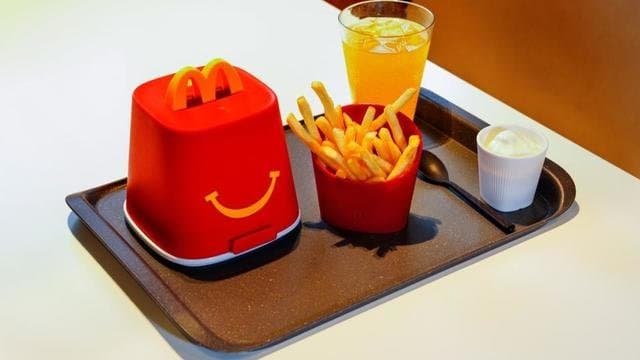
From 1 January 2023, fast food chains must only offer reusable service to their customers when they eat on site. A few days before this measure comes into force, is the fast food sector ready?
On this cold December afternoon, red-cheeked high school students devour a burger upstairs at McDonald’s. In front of them a cone of fritters in bright red plastic, a prototype of the reusable containers that will become mandatory from 1 January in fast food.
“I didn’t realize that, but I think it’s good that it’s mandatory,” agrees Tom Fresneau, 16, who came for lunch with his friend Ilane. “Afterwards it costs more than paper and cardboard, I understand that this is a problem for small fast food restaurants, which risk raising their prices”, he notes.
From January 1, fast food restaurants must use reusable tableware for meals and drinks served at the table, whether they are cups, lids, plates, containers or cutlery, according to the law on combating waste and the circular economy (Agec ) voted in 2020.
180,000 tonnes of waste each year
Fast food chains serve 6 billion meals a year in 30,000 sales points in France, generating 180,000 tons of waste each year. For large chains such as McDonald’s, Quick, KFC or Domino’s Pizza, which use disposable packaging and service in abundance, it is a matter of changing the model.
“It is an emblematic measure. If it is applied well tomorrow, it will make a very concrete difference to people, it is undeniably going in the right direction,” says Moira Tourneur, from the NGO Zero Waste France.
Located on a very commercial thoroughfare, McDonald’s in Levallois-Perret (Hauts-de-Seine) had to recruit “for day diving, hostesses at the reception to accompany customers and explain sorting to them, because it was initially very complicated, and also at counter level and the service at the table”, explains Maria Varela, its director, to AFP.
“Everything that used to be cardboard is now recyclable plastic. We had to go through the procedures in the kitchen, separate the orders on the spot from those that had to be taken away, provide storage space…”, she explains. The renovation work at the establishment gave the opportunity to adapt the narrow kitchen to this new requirement.
Smallpox “often taken away”
This pilot company, which employs 70 people and accounts for 80% of its sales in delivery or take-out – compared to 50% on average for the 1,527 McDonald’s in France – is one of those that has tested different reusable containers of glass or porcelain; before the chain chose titanium plastic, known to be very resistant.
By January 1, 90% of the chain’s restaurants will be ready, according to a spokesperson for McDonald’s France. Customers still sometimes throw the containers in the trash… or take them away, especially young people who are used to finishing their drink outside the establishment.
At Subway, meeting a commitment that “affects 95% of the cups,” according to a spokesperson, also required “several months of experimentation and testing,” an “awareness campaign” with franchisees and indoor displays aimed at customers.
Its use “threatened”?
Despite the “immediate environmental benefit” this measure represents, its use is “under threat”, five NGOs estimate, in a column published by The Sunday Journal the beginning of December.
Because if some players “show goodwill”, it is “very likely that others will miss the deadline of January 1”, worries Surfrider, Zero Waste France, No Plastic in my Sea, Collectif EC2027 and the Consign Network, which urges consumers to “punish signs of not respecting the law” and the government to monitor the application of the law.
In fact, with less than two weeks before the deadline, the major retailers are reluctant to detail their level of preparation and the investment made.
As for the European Packaging Industry (EPPA), it believes that reusable tableware has “ultimately a worse environmental balance than paper packaging”. It “must be washed and dried”, with a lot of “energy, water and detergents”, its president Éric Le Lay emphasized in a recent column.